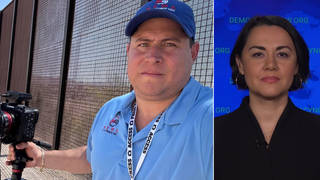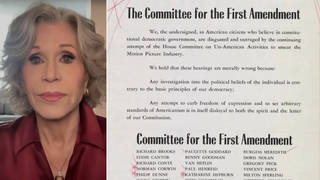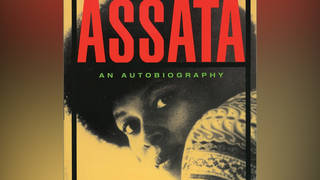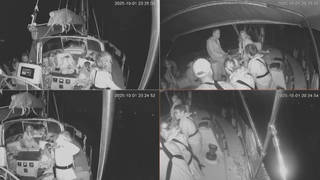
Guests
- Julia Wrightdaughter of Richard Wright.
- Paul Ortizprofessor of history and director of the Samuel Proctor Oral History Program at the University of Florida.
This weekend marked the 103rd anniversary of the 1919 Elaine massacre, one of the deadliest episodes of racial violence in U.S. history. The violence started on September 30, 1919, when guards stopped two white men from breaking into a meeting between Black sharecroppers in Elaine, Arkansas, who were organizing to demand fair payments for their crops. After an exchange of gunfire, a white man was killed. White mobs, backed by the U.S. military, responded with three days of anti-Black violence, indiscriminately killing hundreds of Black people under the false claim of stopping a Black insurrection. Much of the Black farmers’ land was stolen as a result. We speak to Julia Wright, daughter of the acclaimed Black author Richard Wright, who called Elaine home and wrote about his great-uncle Silas Hoskins’s lynching in Elaine three years prior in 1916. Wright says she saw the lynching in a new light after the murder of George Floyd. “Two lynchings separated by so many years and yet so similar,” says Wright. We also speak with Paul Ortiz, historian at the University of Florida, who recalls the nationwide crusade, which included journalist Ida B. Wells, to seek justice for the Black farmers who remained and were taken into custody after the massacre, and ultimately won their freedom.
Transcript
AMY GOODMAN: This is Democracy Now!, democracynow.org, The War and Peace Report. I’m Amy Goodman.
This past weekend marked the 103rd anniversary of one of the worst racial massacres in U.S. history. It took place in Elaine, Arkansas. Before the attack, Elaine was home to Richard Wright, who became one of the most famous Black writers in the United States, known for his acclaimed novel Native Son and his memoir Black Boy, in which he describes how his uncle Silas Hoskins was lynched in 1916 near Elaine by white people who wanted his business. Richard Wright was 9 years old when he and his family were forced to flee. He wrote, quote, “There was only silence, quiet weeping, whispers and fears. Uncle Hoskins had simply been plucked from our midst and we, figuratively, had fallen on our faces to avoid looking into that white-hot face of terror that we knew loomed somewhere above us. This was as close as white terror had ever come to me and my mind reeled. Why had we not fought back, I asked my mother, and the fear that was in her made her slap me into silence.” Those, the words of Richard Wright. He was describing a true story.
Three years later, on September 30th, 1919, a white man was shot and was killed when guards stopped a group of white men from breaking into a meeting of Black sharecroppers with the Progressive Farmers and Household Union of America to demand fair pay for their crops. Mobs of white people responded in Elaine, Arkansas, with three days of anti-Black violence, backed by hundreds of U.S. soldiers. Historians estimate hundreds of Black people were killed, much of their land stolen. The anti-lynching journalist Ida B. Wells investigated the 1919 Elaine massacre and wrote, quote, “Negroes were in a fair way to become independent and it was not to the interest of white landowners to let them do so,” unquote.
This is Elaine, Arkansas, resident Charlie McClain.
CHARLIE McCLAIN: A couple years before the massacre, you know, the price of cotton had gotten — I think it was seven cents a pound at one point. Then it went to 14 cents a pound, six months, a year. Then, another year or two, it went up. It just shot up almost like — almost a dollar a pound. And, you know, when things started moving, you know, from a sharecropper’s perspective, the way that they were treating them, in terms of, you know, every year you do your crop, and you come back, and you owe them. You know, you’ve done all this work. It can roil you. And they did it for a long — you know, for decades. That’s the way that it was.
So, finally, they got wise to it and said, “OK, you know, we can get — if you’re not going to pay us for what we’re worth, what we feel that this is worth, we’re going to unionize ourselves. We’re going to get a lawyer. We’re going to sue you. And we’re going to start picking our cotton everywhere else.”
By the time September 30th happened and they were in that church, it was already a done deal. It was already a powder keg. And the excuse — and the excuse that they needed to quell what they called a Black rebellion was an excuse for them to go and massacre people.
AMY GOODMAN: That’s Charlie McClain, Elaine, Arkansas, resident.
Well, earlier this year, children of the descendants of the 1919 Black massacre in Elaine, Arkansas, gathered memorial soil from where Richard Wright’s uncle, Silas Hoskins, was thought to have been lynched near Elaine, and brought it to the National Memorial for Peace and Justice, the national lynching memorial in Montgomery, Alabama, where founder Bryan Stevenson personally received the jar of memorial soil.
BRYAN STEVENSON: We have Silas Hoskins, Elaine, Arkansas, 1916. And this is a significant one because Silas Hoskins was the uncle of Richard Wright, the very famous author, who wrote amazing books. And Richard Wright talked about what happened to his uncle, and that’s how we know his story. And because you have these two jars, we will be able to put them in our exhibit, and I’m really grateful for that. And so, if you will turn that over, I will take it, and we will put this in our museum. And the next time you come, you’ll be able to see the work that you’ve done. All right? Thank you. Thank you, thank you, thank you.
AMY GOODMAN: For more, we’re joined by Julia Wright, the daughter of the literary giant Richard Wright, and Paul Ortiz, professor of History and director of the Samuel Proctor Oral History Program at University of Florida in Gainesville. They were both part of a symposium this weekend hosted by the Elaine Legacy Center and the Richard Wright Civil Rights Center on this 103rd anniversary of the Elaine massacre.
We welcome you both to Democracy Now! Julia Wright, let’s begin with you. The significance of what took place? You have referred to your uncle Hoskins, your great-uncle Hoskins, Richard Wright’s uncle, as the Black canary in the coal mine. He was killed three years before the massacre. Take it from there.
JULIA WRIGHT: Thank you for having me again, Amy.
Yes, this has been so moving. This has been — taken two years. I didn’t really — I wasn’t sensitive to Silas Hoskins for a long time. It took another reading of Black Boy, after George Floyd was murdered, for me to read Black Boy through the lens of Silas Hoskins’ lynching. Two lynchings are separated by so many years and yet so similar. Reading Black Boy through that lens was chilling.
And I realized then how heavily Silas Hoskins weighed on my father throughout his life. The lynching of Silas Hoskins is a thread, a burning red thread, that can be drawn through practically all his works, from Uncle Tom’s Children, where a Silas is lynched, in fact, to the long dream at the end of his life, where in a town in Mississippi there is also a story of lynchings.
Incredibly, my father never spoke about lynchings to me. He left me to discover that aspect of what is called the American nightmare by myself. And I thank him for it, because I think he was wise. He realized I wasn’t prepared for it. He waited until 1959, when his friend Martin Luther King visited him in Paris on his way to India and spent a day. They spent a day together. Nobody knows what they talked about, because they closed the office doors. And they talked, and they talked, and they talked. But at one point, my father called me — I was 17 years old — and he introduced me to this small light-skinned man, and he looked so familiar to me. I couldn’t place him. And my father said, “This is Martin Luther King, Julia.” And my father turned to Martin Luther King and said, “Martin, I want you to do what we spoke about.” And Martin opened his shirt and showed me the recent scar of his stabbing. And all my father said to me, that I can remember, is, “This is what happens to us, Julia, when we fight for our rights.” Martin remained silent. Silence is something that maybe — there’s a lot to say about Black silence.
AMY GOODMAN: Of course, Martin Luther King, who was stabbed in Chicago, not in the South, in Chicago, where he said he was more afraid. And when he was fighting for housing rights in Chicago for African Americans, he said he was more afraid than he was anywhere in the South.
Now, I wanted to bring in Paul Ortiz. And, Professor Ortiz, I’m glad you made it from Gainesville, from Florida, so hard hit by the hurricane, to Raleigh last night in North Carolina. But the two of you participated virtually in this event this weekend. Talk about what happened 103 years ago. The significance of what the African Americans in Elaine, who were landowners, business owners, professionals, calling for better compensation for their crops, what happened to them?
PAUL ORTIZ: Thank you, Amy. And it’s such a great honor to be with Julia Wright.
And what happened was, was that African Americans in Phillips County, Arkansas, around Elaine, Hoop Spur, were really beginning to get organized. It was the World War I era. The price of cotton was increasing. But most importantly, African Americans were making major gains as landowners in places like Elaine, in places like the Black Belt of Alabama, in northern Florida, all across the South. W. E. B. Du Bois noticed this. And because of these gains and because of the role that African Americans played in World War I, their expectations were rising. And the white power structure mobilized against these rising aspirations.
It’s important to mention, as you mentioned, Amy, that many African Americans in Elaine around Phillips County owned their own land. And those that did not were on the way to becoming landowners. And they were beginning to organize unions in Elaine but all throughout the South. And the Progressive Household Union in Hoop Spur and in Phillips County, Arkansas, was really coming together with a plan not only to increase landownership among Black farmers, but to begin to farm and market their produce cooperatively. And this was seen as a threat by the white power structure. They mobilized against it.
They began to attack farmers, Black farmers, even before the Elaine massacre. And Julia Wright mentioned her great-uncle, Silas Hoskins, who was lynched because he was a successful Black businessman. And so, all of this came to a head during the Elaine massacre, when Black farmers in Phillips County reached a level of organization where hundreds of Black farmers were joining the union. And this is when the white power structure struck back.
And there’s a number of legacies that come out of this, Amy, that we tried to address at the 103rd anniversary of the Elaine massacre, organized by the Elaine Legacy Center in Elaine, Arkansas. You know, one of the legacies is this legacy of Black land loss, that African American farmers have been driven off the land in places like Elaine, in places like Florida, in places like Mississippi.
Another legacy, as Judge Wendell Griffen said at the symposium, is the criminal justice system. Amy, it’s important remember that hundreds of African Americans were massacred in and around Phillips County, Arkansas, in 1919. Not a single white perpetrator of this violence was ever put on trial. Instead, African American farmers were put on trial. They were known as the Elaine 12. A nationwide crusade, organized by people that you mentioned, Ida B. Wells, the NAACP, Walter White, Scipio Jones, a local Black attorney, very heroic gentleman, they had to organize a national defense campaign to help get these men some justice. It results in Moore v. Dempsey, a landmark Supreme Court case in 1923 in which the 14th Amendment is brought to bear. The convictions of those men — six of them, by the way, convicted, sentenced to death, all of them tortured brutally, electrocuted, whipped and coerced into testifying against their peers.
AMY GOODMAN: And, Professor Ortiz, there were 500 U.S. soldiers who were involved in the killing of hundreds of African Americans in this massacre?
PAUL ORTIZ: Yes, Amy. This made a cover-up much more difficult compared to other anti-Black massacres, say, in Rosewood, Florida, or Ocoee, the Ocoee massacre in Florida. The governor requested federal troops. These troops were supposed to restore order. In fact, many of them engaged in the massacre. They shot people down in the streets.
AMY GOODMAN: We have 10 seconds, Paul.
PAUL ORTIZ: They shot — they shot people down in the woods. And so, again, those murders were never prosecuted.
AMY GOODMAN: Well, we can’t leave it there, so we’re going to continue this conversation and bring you Part 2 at democracynow.org. Paul Ortiz, professor of history and director of the Samuel Proctor Oral History Program at University of Florida, Gainesville. And Julia Wright, the daughter of the literary giant Richard Wright, who wrote Black Boy and Native Son.
That does it for our show. Happy birthday, Becca Staley! I’ll be speaking at UPenn — I mean, at Penn State and at Brown this week. Check democracynow.org. I’m Amy Goodman.











Media Options